Answered step by step
Verified Expert Solution
Question
1 Approved Answer
1. Why should healthcare organizations plan? a. The future is certain. b. To provide a road map and guide organizations through the unknown. c. Organizations
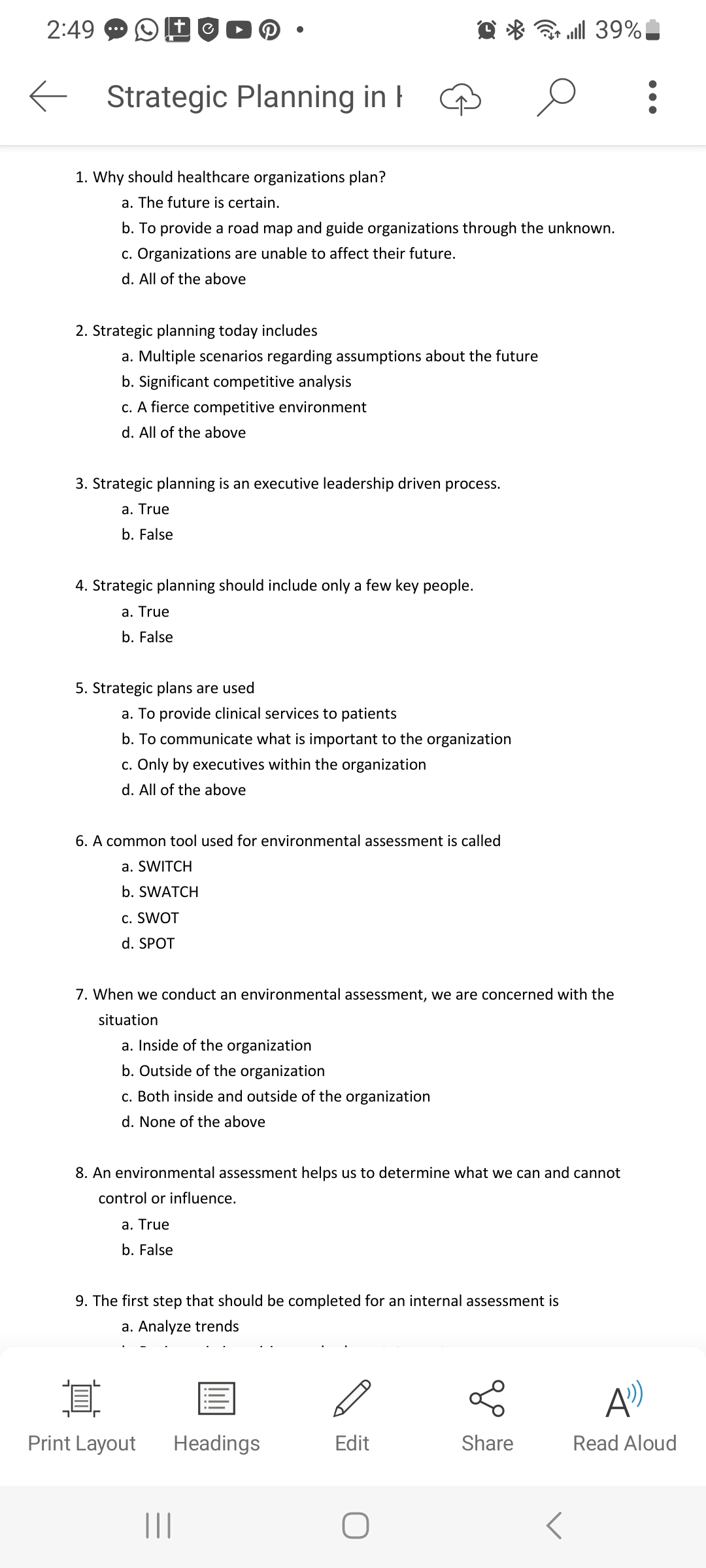
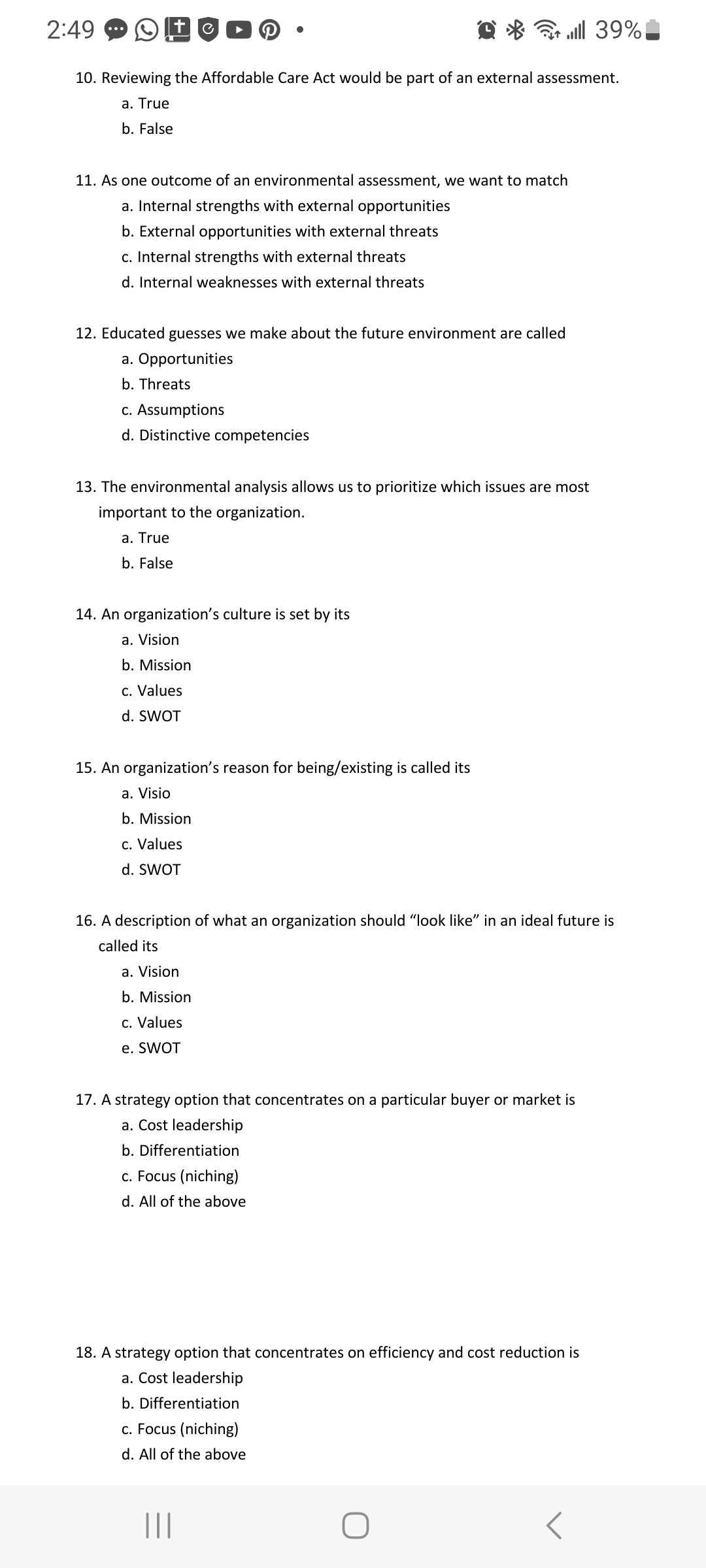
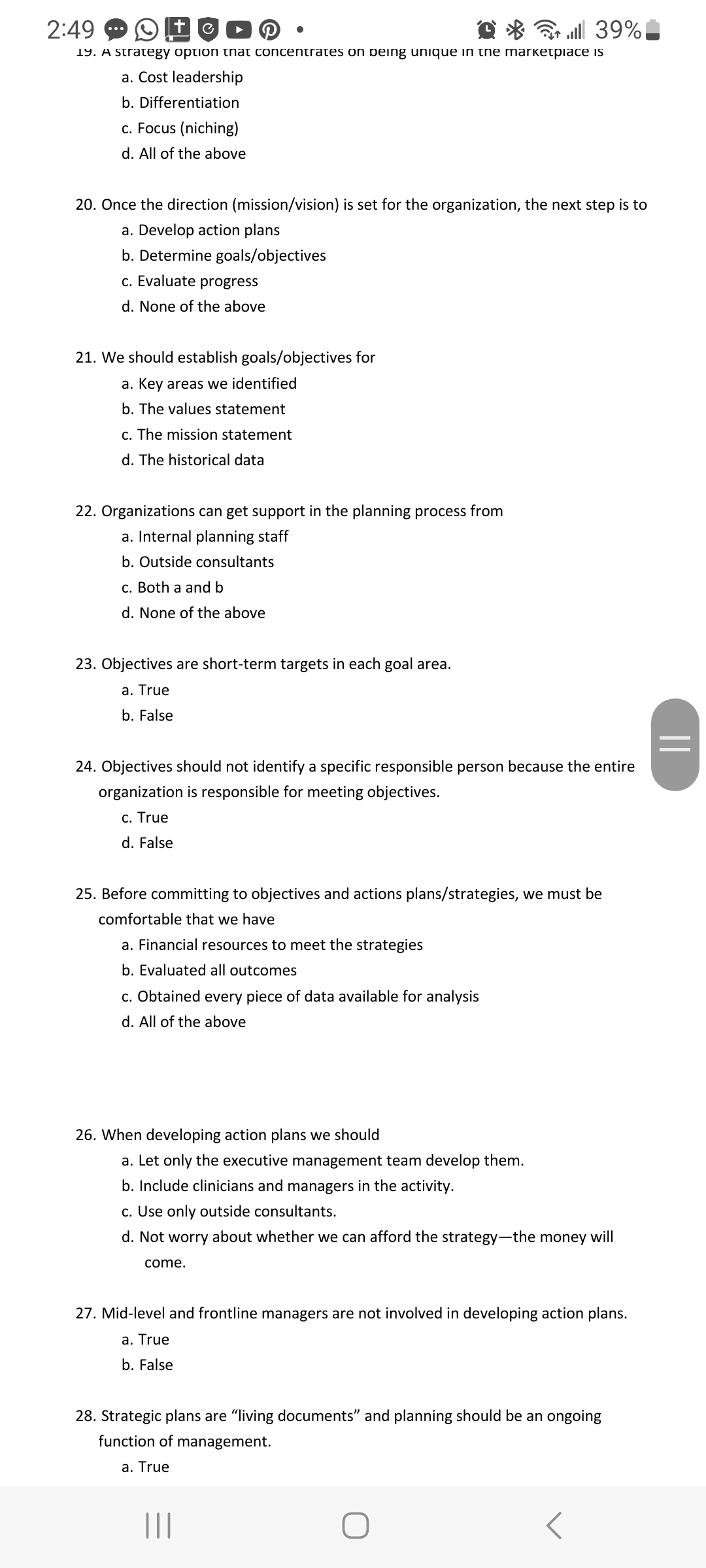

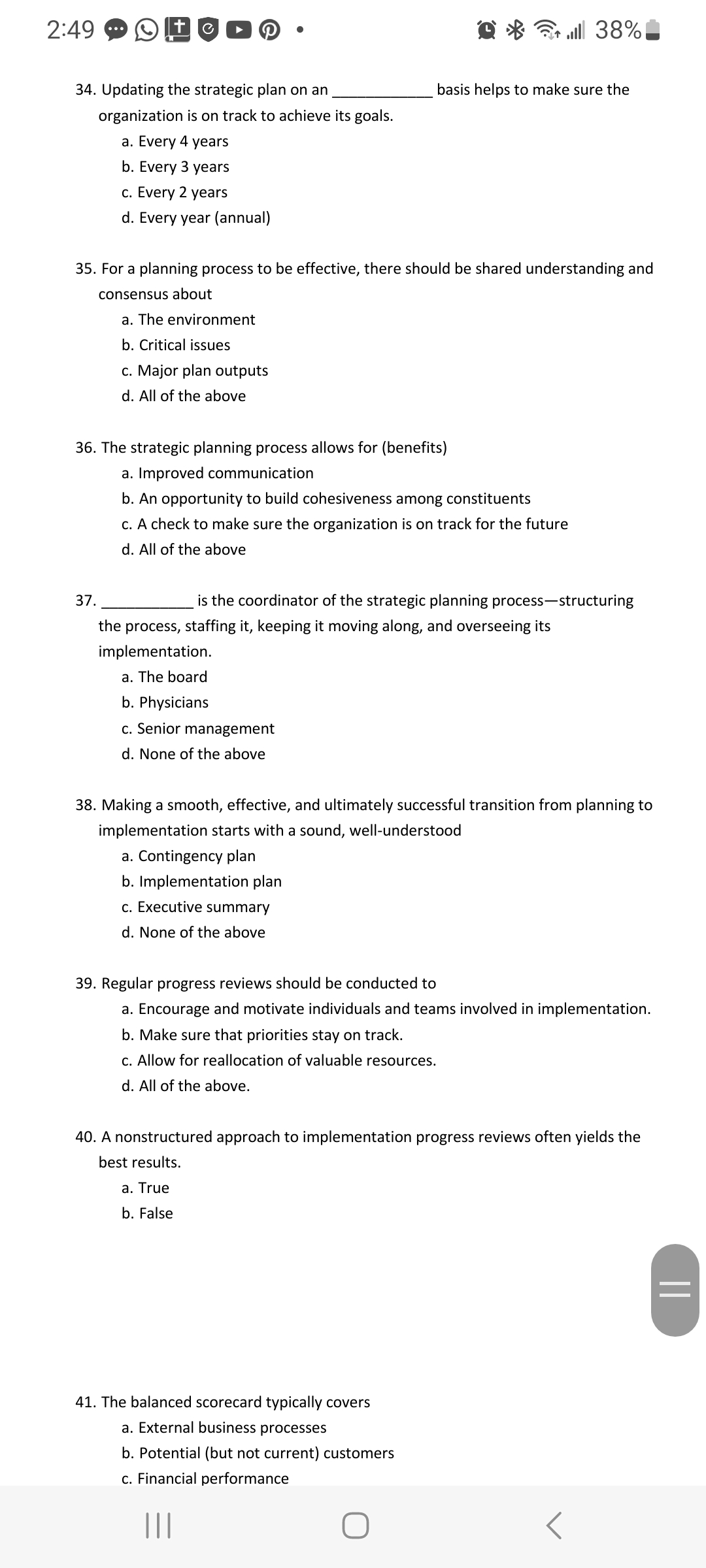
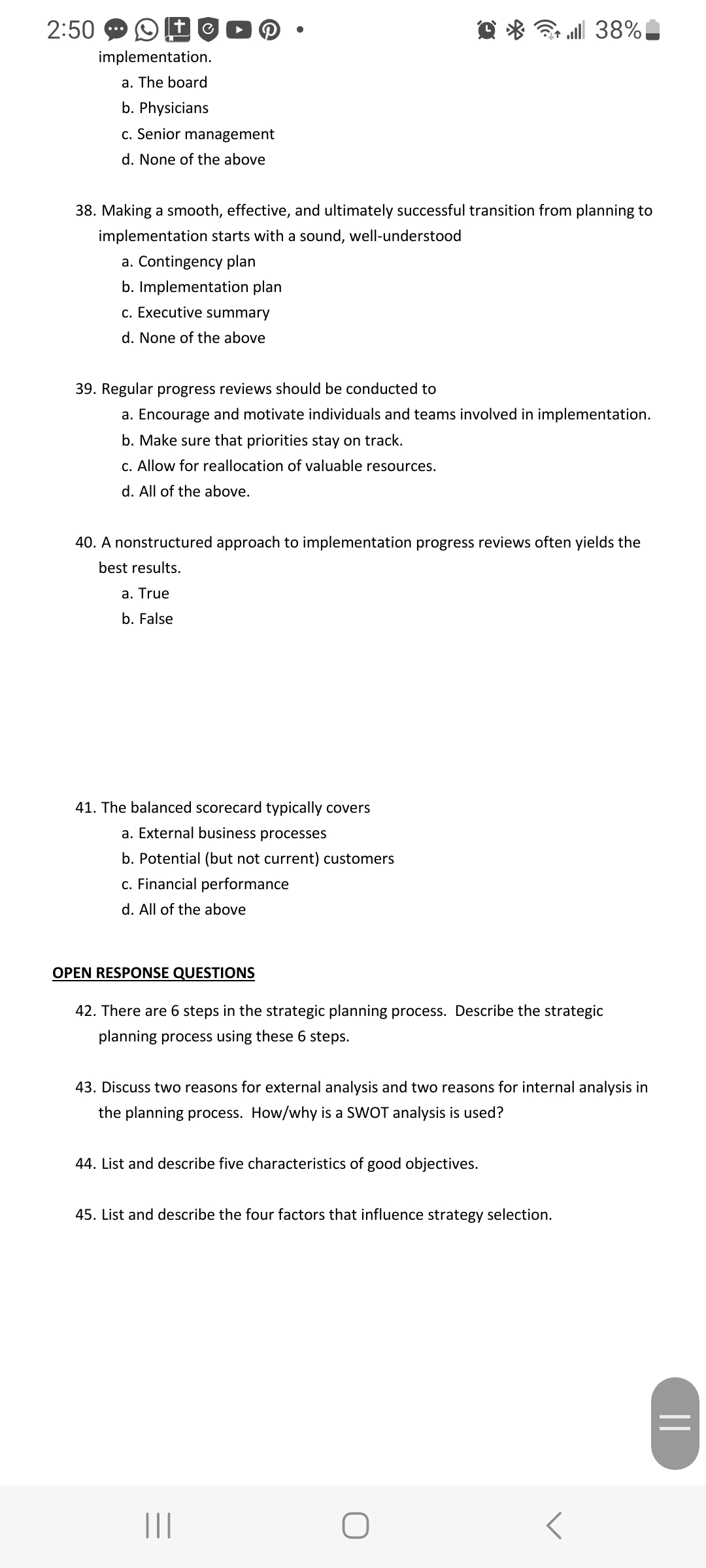 1. Why should healthcare organizations plan? a. The future is certain. b. To provide a road map and guide organizations through the unknown. c. Organizations are unable to affect their future. d. All of the above 2. Strategic planning today includes a. Multiple scenarios regarding assumptions about the future b. Significant competitive analysis c. A fierce competitive environment d. All of the above 3. Strategic planning is an executive leadership driven process. a. True b. False 4. Strategic planning should include only a few key people. a. True b. False 5. Strategic plans are used a. To provide clinical services to patients b. To communicate what is important to the organization c. Only by executives within the organization d. All of the above 6. A common tool used for environmental assessment is called a. SWITCH b. SWATCH c. SWOT d. SPOT 7. When we conduct an environmental assessment, we are concerned with the situation a. Inside of the organization b. Outside of the organization c. Both inside and outside of the organization d. None of the above 8. An environmental assessment helps us to determine what we can and cannot control or influence. a. True b. False 9. The first step that should be completed for an internal assessment is a. Analyze trends c 10. Reviewing the Affordable Care Act would be part of an external assessment. a. True b. False 11. As one outcome of an environmental assessment, we want to match a. Internal strengths with external opportunities b. External opportunities with external threats c. Internal strengths with external threats d. Internal weaknesses with external threats 12. Educated guesses we make about the future environment are called a. Opportunities b. Threats c. Assumptions d. Distinctive competencies 13. The environmental analysis allows us to prioritize which issues are most important to the organization. a. True b. False 14. An organization's culture is set by its a. Vision b. Mission c. Values d. SWOT 15. An organization's reason for being/existing is called its a. Visio b. Mission c. Values d. SWOT 16. A description of what an organization should "look like" in an ideal future is called its a. Vision b. Mission c. Values e. SWOT 17. A strategy option that concentrates on a particular buyer or market is a. Cost leadership b. Differentiation c. Focus (niching) d. All of the above 18. A strategy option that concentrates on efficiency and cost reduction is a. Cost leadership b. Differentiation c. Focus (niching) d. All of the above 1y. A strategy option tnat concentrates on Deing unque in tne marketpace is a. Cost leadership b. Differentiation c. Focus (niching) d. All of the above 20. Once the direction (mission/vision) is set for the organization, the next step is to a. Develop action plans b. Determine goals/objectives c. Evaluate progress d. None of the above 21. We should establish goals/objectives for a. Key areas we identified b. The values statement c. The mission statement d. The historical data 22. Organizations can get support in the planning process from a. Internal planning staff b. Outside consultants c. Both a and b d. None of the above 23. Objectives are short-term targets in each goal area. a. True b. False 24. Objectives should not identify a specific responsible person because the entire organization is responsible for meeting objectives. c. True d. False 25. Before committing to objectives and actions plans/strategies, we must be comfortable that we have a. Financial resources to meet the strategies b. Evaluated all outcomes c. Obtained every piece of data available for analysis d. All of the above 26. When developing action plans we should a. Let only the executive management team develop them. b. Include clinicians and managers in the activity. c. Use only outside consultants. d. Not worry about whether we can afford the strategy-the money will come. 27. Mid-level and frontline managers are not involved in developing action plans. a. True b. False 28. Strategic plans are "living documents" and planning should be an ongoing function of management. a. True 26. When developing action plans we should a. Let only the executive management team develop them. b. Include clinicians and managers in the activity. c. Use only outside consultants. d. Not worry about whether we can afford the strategy-the money will come. 27. Mid-level and frontline managers are not involved in developing action plans. a. True b. False 28. Strategic plans are "living documents" and planning should be an ongoing function of management. a. True b. False 29. One reason that effective strategy implementation would be doomed to fail is a. The strategy has rigor, insight, vision, ambition, and practicality. b. People are sure how the strategy is to be implemented. c. The strategy is communicated on a "need to know" basis. d. Individuals are responsible for each aspect of strategy implementation. 30. Objectives should the organization but also be a. Guide; set only by the board b. Stretch; implemented regardless of cost c. Seriously considered; considered general guidelines only d. Stretch; achievable 31. The board should understand the strategic plan and how it will help the organization move toward satisfying its mission. a. True b. False 32. Once the strategic plan is written you do not have to worry about conducting external analysis again until the next cycle. a. True b. False 33. are used when something unexpected disrupts operations. a. Strategic plans b. Contingency plans c. Budgets d. Action plans 34. Updating the strategic plan on an basis helps to make sure the organization is on track to achieve its goals. a. Every 4 years b. Every 3 years c. Every 2 years d. Every year (annual) 34. Updating the strategic plan on an basis helps to make sure the organization is on track to achieve its goals. a. Every 4 years b. Every 3 years c. Every 2 years d. Every year (annual) 35. For a planning process to be effective, there should be shared understanding and consensus about a. The environment b. Critical issues c. Major plan outputs d. All of the above 36. The strategic planning process allows for (benefits) a. Improved communication b. An opportunity to build cohesiveness among constituents c. A check to make sure the organization is on track for the future d. All of the above 37. is the coordinator of the strategic planning process-structuring the process, staffing it, keeping it moving along, and overseeing its implementation. a. The board b. Physicians c. Senior management d. None of the above 38. Making a smooth, effective, and ultimately successful transition from planning to implementation starts with a sound, well-understood a. Contingency plan b. Implementation plan c. Executive summary d. None of the above 39. Regular progress reviews should be conducted to a. Encourage and motivate individuals and teams involved in implementation. b. Make sure that priorities stay on track. c. Allow for reallocation of valuable resources. d. All of the above. 40. A nonstructured approach to implementation progress reviews often yields the best results. a. True b. False 41. The balanced scorecard typically covers a. External business processes b. Potential (but not current) customers c. Financial performance implementation. a. The board b. Physicians c. Senior management d. None of the above 38. Making a smooth, effective, and ultimately successful transition from planning to implementation starts with a sound, well-understood a. Contingency plan b. Implementation plan c. Executive summary d. None of the above 39. Regular progress reviews should be conducted to a. Encourage and motivate individuals and teams involved in implementation. b. Make sure that priorities stay on track. c. Allow for reallocation of valuable resources. d. All of the above. 40. A nonstructured approach to implementation progress reviews often yields the best results. a. True b. False 41. The balanced scorecard typically covers a. External business processes b. Potential (but not current) customers c. Financial performance d. All of the above OPEN RESPONSE QUESTIONS 42. There are 6 steps in the strategic planning process. Describe the strategic planning process using these 6 steps. 43. Discuss two reasons for external analysis and two reasons for internal analysis in the planning process. How/why is a SWOT analysis is used? 44. List and describe five characteristics of good objectives
1. Why should healthcare organizations plan? a. The future is certain. b. To provide a road map and guide organizations through the unknown. c. Organizations are unable to affect their future. d. All of the above 2. Strategic planning today includes a. Multiple scenarios regarding assumptions about the future b. Significant competitive analysis c. A fierce competitive environment d. All of the above 3. Strategic planning is an executive leadership driven process. a. True b. False 4. Strategic planning should include only a few key people. a. True b. False 5. Strategic plans are used a. To provide clinical services to patients b. To communicate what is important to the organization c. Only by executives within the organization d. All of the above 6. A common tool used for environmental assessment is called a. SWITCH b. SWATCH c. SWOT d. SPOT 7. When we conduct an environmental assessment, we are concerned with the situation a. Inside of the organization b. Outside of the organization c. Both inside and outside of the organization d. None of the above 8. An environmental assessment helps us to determine what we can and cannot control or influence. a. True b. False 9. The first step that should be completed for an internal assessment is a. Analyze trends c 10. Reviewing the Affordable Care Act would be part of an external assessment. a. True b. False 11. As one outcome of an environmental assessment, we want to match a. Internal strengths with external opportunities b. External opportunities with external threats c. Internal strengths with external threats d. Internal weaknesses with external threats 12. Educated guesses we make about the future environment are called a. Opportunities b. Threats c. Assumptions d. Distinctive competencies 13. The environmental analysis allows us to prioritize which issues are most important to the organization. a. True b. False 14. An organization's culture is set by its a. Vision b. Mission c. Values d. SWOT 15. An organization's reason for being/existing is called its a. Visio b. Mission c. Values d. SWOT 16. A description of what an organization should "look like" in an ideal future is called its a. Vision b. Mission c. Values e. SWOT 17. A strategy option that concentrates on a particular buyer or market is a. Cost leadership b. Differentiation c. Focus (niching) d. All of the above 18. A strategy option that concentrates on efficiency and cost reduction is a. Cost leadership b. Differentiation c. Focus (niching) d. All of the above 1y. A strategy option tnat concentrates on Deing unque in tne marketpace is a. Cost leadership b. Differentiation c. Focus (niching) d. All of the above 20. Once the direction (mission/vision) is set for the organization, the next step is to a. Develop action plans b. Determine goals/objectives c. Evaluate progress d. None of the above 21. We should establish goals/objectives for a. Key areas we identified b. The values statement c. The mission statement d. The historical data 22. Organizations can get support in the planning process from a. Internal planning staff b. Outside consultants c. Both a and b d. None of the above 23. Objectives are short-term targets in each goal area. a. True b. False 24. Objectives should not identify a specific responsible person because the entire organization is responsible for meeting objectives. c. True d. False 25. Before committing to objectives and actions plans/strategies, we must be comfortable that we have a. Financial resources to meet the strategies b. Evaluated all outcomes c. Obtained every piece of data available for analysis d. All of the above 26. When developing action plans we should a. Let only the executive management team develop them. b. Include clinicians and managers in the activity. c. Use only outside consultants. d. Not worry about whether we can afford the strategy-the money will come. 27. Mid-level and frontline managers are not involved in developing action plans. a. True b. False 28. Strategic plans are "living documents" and planning should be an ongoing function of management. a. True 26. When developing action plans we should a. Let only the executive management team develop them. b. Include clinicians and managers in the activity. c. Use only outside consultants. d. Not worry about whether we can afford the strategy-the money will come. 27. Mid-level and frontline managers are not involved in developing action plans. a. True b. False 28. Strategic plans are "living documents" and planning should be an ongoing function of management. a. True b. False 29. One reason that effective strategy implementation would be doomed to fail is a. The strategy has rigor, insight, vision, ambition, and practicality. b. People are sure how the strategy is to be implemented. c. The strategy is communicated on a "need to know" basis. d. Individuals are responsible for each aspect of strategy implementation. 30. Objectives should the organization but also be a. Guide; set only by the board b. Stretch; implemented regardless of cost c. Seriously considered; considered general guidelines only d. Stretch; achievable 31. The board should understand the strategic plan and how it will help the organization move toward satisfying its mission. a. True b. False 32. Once the strategic plan is written you do not have to worry about conducting external analysis again until the next cycle. a. True b. False 33. are used when something unexpected disrupts operations. a. Strategic plans b. Contingency plans c. Budgets d. Action plans 34. Updating the strategic plan on an basis helps to make sure the organization is on track to achieve its goals. a. Every 4 years b. Every 3 years c. Every 2 years d. Every year (annual) 34. Updating the strategic plan on an basis helps to make sure the organization is on track to achieve its goals. a. Every 4 years b. Every 3 years c. Every 2 years d. Every year (annual) 35. For a planning process to be effective, there should be shared understanding and consensus about a. The environment b. Critical issues c. Major plan outputs d. All of the above 36. The strategic planning process allows for (benefits) a. Improved communication b. An opportunity to build cohesiveness among constituents c. A check to make sure the organization is on track for the future d. All of the above 37. is the coordinator of the strategic planning process-structuring the process, staffing it, keeping it moving along, and overseeing its implementation. a. The board b. Physicians c. Senior management d. None of the above 38. Making a smooth, effective, and ultimately successful transition from planning to implementation starts with a sound, well-understood a. Contingency plan b. Implementation plan c. Executive summary d. None of the above 39. Regular progress reviews should be conducted to a. Encourage and motivate individuals and teams involved in implementation. b. Make sure that priorities stay on track. c. Allow for reallocation of valuable resources. d. All of the above. 40. A nonstructured approach to implementation progress reviews often yields the best results. a. True b. False 41. The balanced scorecard typically covers a. External business processes b. Potential (but not current) customers c. Financial performance implementation. a. The board b. Physicians c. Senior management d. None of the above 38. Making a smooth, effective, and ultimately successful transition from planning to implementation starts with a sound, well-understood a. Contingency plan b. Implementation plan c. Executive summary d. None of the above 39. Regular progress reviews should be conducted to a. Encourage and motivate individuals and teams involved in implementation. b. Make sure that priorities stay on track. c. Allow for reallocation of valuable resources. d. All of the above. 40. A nonstructured approach to implementation progress reviews often yields the best results. a. True b. False 41. The balanced scorecard typically covers a. External business processes b. Potential (but not current) customers c. Financial performance d. All of the above OPEN RESPONSE QUESTIONS 42. There are 6 steps in the strategic planning process. Describe the strategic planning process using these 6 steps. 43. Discuss two reasons for external analysis and two reasons for internal analysis in the planning process. How/why is a SWOT analysis is used? 44. List and describe five characteristics of good objectives Step by Step Solution
There are 3 Steps involved in it
Step: 1

Get Instant Access to Expert-Tailored Solutions
See step-by-step solutions with expert insights and AI powered tools for academic success
Step: 2

Step: 3

Ace Your Homework with AI
Get the answers you need in no time with our AI-driven, step-by-step assistance
Get Started


